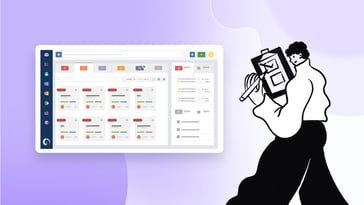Patch Management and Vulnerability Management are two key practices that keep organizations safe. Used effectively, they can detect vulnerabilities, patch them efficiently and safely, and help organizations meet their Governance, Risk, and Compliance (GRC) requirements.
Because both practices work together to build up an organization’s IT security strategy, they are often incorrectly used interchangeably. Here, we will explore what sets them apart, to understand how they combine their areas of practice. We will also see how InvGate Asset Management can help you streamline both processes to keep organizations thoroughly protected.
Ready to go? Let’s start.

Patch Management overview
Patch Management is the process of testing and deploying patches to protect your environment from security threats. Patches are codes inserted into a software program to fix a vulnerability or bug or improve the service being patched.
Major software vendors regularly release patches for their operating systems and products to protect their customers, meet industry requirements, and comply with best practices.
Vulnerability Management, in a nutshell
Vulnerability Management, on the other hand, is the practice that identifies, categorizes, prioritizes, and solves operating system and software vulnerabilities.
Vulnerabilities are security flaws, glitches, or weaknesses found in software code, which an attacker could exploit. This practice ensures these threats are captured, identified, and prioritized so the Patch Management process can act on them.
Patch Management vs. Vulnerability Management: similarities and differences
When it comes to IT security, Patch Management and Vulnerability Management are essential components that often overlap yet serve distinct purposes. To simplify their comparison, we’ve summarized their key similarities and differences below.
We chose these points because they highlight the most critical aspects of how these practices complement and differ from each other, providing a clear foundation for understanding their roles:
- IT security best practice: Both are vital to maintaining a secure IT environment. Vulnerability Management identifies risks, while Patch Management addresses them with fixes, making them two sides of the same coin in security.
- Lifecycle approach: Both practices adopt lifecycle management tailored to their focus areas—tracking vulnerabilities or managing patches. This ensures ongoing protection and adaptability to evolving threats.
- Risk mitigation: At their core, both aim to reduce organizational risk. Vulnerability Management highlights what needs attention, while Patch Management ensures those vulnerabilities are resolved.
- Compliance Management: These practices are pivotal for meeting IT compliance standards. Vulnerability Management identifies gaps, and Patch Management ensures those gaps are patched.
- Continuous operation: Both rely on ongoing processes—continuous vulnerability assessments and patch deployment—to address emerging threats effectively.
These points were chosen to give a balanced view of their roles, and in the next sections, we’ll explore each of these areas in more depth.
What are the similarities between Patch and Vulnerability Management?
Patch and Vulnerability Management are closely related components, here are the key similarities between the two:
#1: IT security strategy
Both Patch Management and Vulnerability Management are integral components of a strong IT security strategy. While their methods differ, their shared goal is to protect IT systems from threats:
- Patch Management strengthens security by updating software and systems with the latest security patches, addressing known vulnerabilities quickly.
- Vulnerability Management identifies and mitigates vulnerabilities, continually polling the threat landscape for potential new threats. This proactive monitoring ensures that organizations stay ahead of emerging risks.
By working together, these practices create a layered approach to security, addressing both identified risks and unknown threats.
#2: Risk Mitigation processes
Risk mitigation is at the core of both practices.
- Vulnerability Management identifies vulnerabilities within the IT ecosystem and prioritizes them based on risk levels, ensuring the most critical threats are addressed first.
- Patch Management then works to eliminate these vulnerabilities by deploying updates, reducing the likelihood of exploitation by attackers.
Together, they form a comprehensive defense system that identifies risks, resolves them, and minimizes the chances of successful cyberattacks.

#3: Customer requirements
In today’s cybersecurity landscape, customers expect robust security practices to protect their data and operations.
- Transparent and proactive Patch Management and Vulnerability Management processes demonstrate your commitment to security.
- By consistently addressing vulnerabilities and maintaining secure systems, organizations can reassure customers, partners, and stakeholders that their operations are protected against threats.
Meeting customer expectations in this area not only strengthens trust but also enhances reputation and competitiveness.
#4: Compliance requirements
Both practices play a critical role in meeting compliance obligations, such as industry standards, regulatory mandates, legal requirements, and internal security policies:
- Vulnerability Management identifies and addresses security gaps that could lead to non-compliance.
- Patch Management completes this process by patching those vulnerabilities, ensuring systems remain compliant.
Maintaining compliance not only avoids penalties but also reinforces an organization’s commitment to secure and responsible operations.
#5: Continuous processes
Both Patch Management and Vulnerability Management operate as continuous processes because the threat landscape is always evolving:
- Vulnerability Management continuously scans for new vulnerabilities, identifying emerging threats that require action.
- Patch Management leverages ongoing monitoring and updates to deploy fixes quickly and efficiently.
This iterative approach ensures both practices remain effective in adapting to new challenges and safeguarding the organization.
#6: Dependency on other processes
For optimal performance, Patch Management and Vulnerability Management rely on other IT processes:
- Configuration Management provides a comprehensive view of the IT ecosystem, capturing the components and relationships of IT services. This information makes it easier to scan and inventory assets, identify vulnerabilities, and deploy patches effectively.
- Change Enablement helps prioritize and expedite critical patching tasks, ensuring that urgent security fixes take precedence over routine changes while minimizing service disruption.
These dependencies highlight the interconnected nature of IT processes and emphasize the need for a holistic approach to IT management.
#7: Balance between speed and effectiveness
Striking the right balance between speed and thoroughness is essential for both practices:
- Vulnerability Management needs to quickly recognize and assess threats, prioritizing them based on impact and urgency.
- Patch Management must deploy patches as fast as possible while ensuring they are tested, planned, and released safely. This includes mitigating risks to prevent service disruption and ensuring the patch integrates smoothly into the environment.
This balance ensures vulnerabilities are addressed effectively without compromising the stability of IT systems.
#8: Documentation and reporting
Both practices require robust documentation and reporting for accountability and improvement:
- Vulnerability Management records scanning activities, identified threats, and remediation actions taken.
- Patch Management tracks updates deployed, testing results, and patching schedules.
These records are crucial for audits, compliance checks, technical decision-making, and identifying areas for improvement. Maintaining detailed documentation ensures transparency and enables organizations to refine their processes over time.
What are the differences between Patch and Vulnerability Management?
However, while Patch and Vulnerability Management are essential for cybersecurity, their scope and processes differ.
If it makes it easier to understand, consider them as being on two sides of the same coin; Vulnerability Management identifies vulnerabilities and threats, and Patch Management then fixes them by deploying software patches.
Here are the key differences between the two:
#1 - Scope: narrow vs. comprehensive focus
While Patch Management zeroes in on software updates and patches provided by vendors to address specific vulnerabilities, Vulnerability Management takes a broader view. It identifies, assesses, and prioritizes vulnerabilities across an organization’s entire IT environment, including hardware, software, and network infrastructure. Patch Management is one piece of the puzzle, whereas Vulnerability Management encompasses the entire landscape of potential risks.
#2 - Activities: deployment vs. holistic risk assessment
The activities involved in each practice highlight their different approaches. Patch Management focuses on identifying patches, testing their compatibility, deploying them in alignment with organizational processes like Change Management, and monitoring to ensure successful application.
Vulnerability Management includes scanning the IT environment for vulnerabilities, assessing their severity and likelihood of exploitation, creating remediation plans, and continuously monitoring risks. It’s a more comprehensive process that often informs the actions taken during Patch Management.
#3 - Reporting: deployment metrics vs. threat insights
The type of reporting also sets these practices apart. Patch Management reports focus on metrics like deployment status, success rates, and compliance with patching policies, ensuring updates are applied efficiently and effectively.
Vulnerability Management reports dive deeper into threat assessments, the prioritization of vulnerabilities based on risk levels, and remediation strategies. These reports provide a higher-level view of the organization’s security posture and guide strategic decision-making.

How do Patch and Vulnerability Management work together?
The two practices work together effectively to enhance an organization's cybersecurity posture by addressing known vulnerabilities and reducing security risks. When implementing them across organizations, an IT Asset Management (ITAM) tool can make a big difference to streamline operations and reduce human errors.
Here are ways in which both processes can be integrated and coordinated and how InvGate Asset Management can help you along the implementation process:
#1: Understanding and mapping your IT environment
The first step in integrating Patch Management and Vulnerability Management is understanding your IT environment. A comprehensive IT asset inventory is crucial for identifying what needs to be protected, patched, or monitored. Tools like InvGate Asset Management help you create a detailed map of your IT landscape, ensuring no assets slip through the cracks.
This clarity allows you to set the right scope for vulnerability scanning, prioritize critical services, and deploy patches effectively, keeping your cybersecurity efforts laser-focused.
#2: Regular scanning to identify and mitigate vulnerabilities
Vulnerability Management takes the lead in scanning your IT environment to uncover weaknesses. These scans identify software or services that need attention—whether that’s applying patches or implementing alternative measures to secure sensitive data.
InvGate Asset Management’s robust search capabilities make this easier by helping you identify outdated or vulnerable devices. From there, you can strategize patch deployment in a way that’s efficient and impactful, ensuring your systems stay ahead of potential threats.
#3: Prioritizing patching and mitigating vulnerabilities
Prioritization is where the magic happens. In Vulnerability Management, vulnerabilities are ranked based on their severity and the potential impact of exploitation. This creates a roadmap for action. Patch Management then picks up the baton, prioritizing patches that address the most critical vulnerabilities first.
By tackling high-risk areas, your organization can minimize exposure and protect vital systems. InvGate Asset Management helps by providing visibility into your environment, making it easier to determine which assets need immediate attention.
#4: Automating for efficiency
Automation is the secret sauce that ties everything together. By automating patch deployment, organizations can patch devices quickly and consistently, ensuring vulnerabilities are addressed without manual errors or delays. Tools like InvGate Asset Management allow you to automate patch deployment across various systems once vulnerabilities are identified.
This not only saves time but ensures consistency in your security approach, enabling your IT team to focus on strategic initiatives rather than repetitive tasks.
#5: Aligning with IT Service Management
Strong integration with IT Service Management (ITSM) practices ensures that patching and vulnerability mitigation activities are structured and well-coordinated. Practices like Change Enablement ensure that patches are deployed with minimal disruption, while Event Management helps monitor for signs of emerging vulnerabilities.
InvGate Asset Management’s integration with InvGate Service Management takes this a step further, enabling you to create workflows that blend ITAM and ITSM seamlessly. This holistic approach enhances both operational efficiency and security.
#6: Driving continual improvement
Cybersecurity is never a one-and-done effort—it’s an ongoing journey. Building continual improvement into your Patch Management and Vulnerability Management processes ensures they evolve alongside your business and the ever-changing threat landscape.
Regularly reviewing and updating your practices allows you to meet new challenges head-on, stay compliant with regulatory changes, and refine your operations for greater efficiency. With tools like InvGate Asset Management, you can ensure that your processes remain dynamic and responsive to the demands of modern IT environments.
In short
Patch Management and Vulnerability Management are essential for building a robust IT security strategy. While Vulnerability Management identifies and prioritizes risks, Patch Management addresses them by deploying updates effectively. Together, they reduce vulnerabilities, mitigate risks, and ensure compliance.
With tools like InvGate Asset Management, these processes become streamlined, automated, and integrated with broader IT operations, helping organizations stay secure and adaptable. By embracing this synergy, you’re not just reacting to threats—you’re proactively protecting your IT environment for the future.
If you want to see what InvGate Asset Management can do for your organization’s IT security strategy, don’t hesitate to ask for a 30 day free trial and look through it in your own time.















